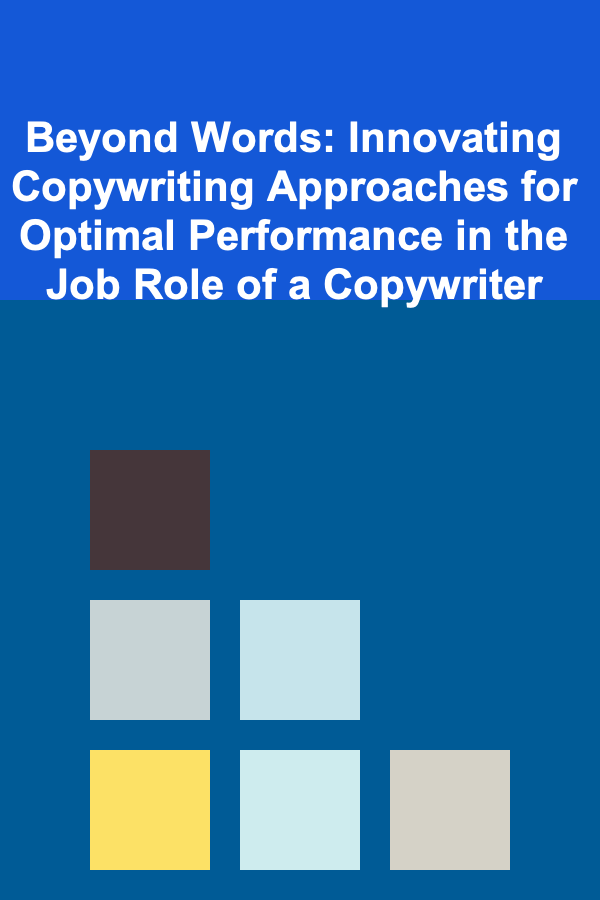
Beyond Words: Innovating Copywriting Approaches for Optimal Performance in the Job Role of a Copywriter
ebook include PDF & Audio bundle (Micro Guide)
$12.99$5.99
Limited Time Offer! Order within the next:

The role of a copywriter is often misunderstood. It's not simply about putting words on a page or crafting catchy slogans. It's about using the power of language to drive action, evoke emotions, and shape perceptions. As the world becomes increasingly digital and competitive, the traditional methods of copywriting are no longer enough. To thrive in today's fast-paced and highly dynamic market, copywriters must innovate and evolve their approaches to ensure optimal performance.
This guide aims to explore how copywriters can push the boundaries of traditional copywriting techniques, embracing innovation to achieve better results in their craft. Whether you're an experienced professional or just starting, this actionable guide will provide valuable insights into how you can elevate your performance, boost creativity, and achieve lasting impact with your writing.
The Evolution of Copywriting: From Print to Digital
In the past, copywriting was largely confined to print media---newspapers, magazines, billboards, and brochures. These mediums required concise, persuasive copy, often relying on traditional formats like headline, body, and call to action. However, the advent of digital media and the explosion of social platforms have transformed the way we approach copywriting.
Embrace Multi-Channel Copywriting
One of the most significant changes in copywriting is the rise of multi-channel marketing. Today, a successful copywriter must be adept at writing for various platforms, including:
- Websites and Landing Pages: Focus on SEO optimization, user experience (UX), and clear calls to action.
- Social Media: Adapt tone and style to match the platform (e.g., Twitter's brevity vs. Instagram's visual storytelling).
- Emails: Develop effective email marketing strategies that balance personalization, urgency, and value propositions.
- Video Scripts: With video content taking over the digital space, mastering scriptwriting for YouTube, Facebook, and TikTok has become essential.
- Ad Copy: Whether it's Google Ads or Facebook ads, writing copy that stops users from scrolling requires precision and innovation.
A key to excelling in the digital age is to leverage the strengths of each platform while maintaining a consistent brand voice and message across all channels.
Data-Driven Copywriting: Harnessing the Power of Analytics
Gone are the days when copywriting was purely based on intuition and creativity. In today's data-driven world, the most effective copywriters rely on analytics to guide their writing decisions. By understanding what works and what doesn't, copywriters can continuously improve their craft and produce higher-performing content.
A/B Testing: The Key to Optimization
A/B testing, also known as split testing, is a powerful method that allows copywriters to experiment with different versions of their content. By comparing two variations of a headline, call to action, or even the body copy, you can see which performs better with your target audience.
- Headlines: Test multiple headlines to see which attracts more clicks or engagement.
- CTAs: Test variations of your call-to-action buttons to determine which phrase or design leads to higher conversion rates.
- Email Subject Lines: The first thing readers see in an email is the subject line, so A/B testing subject lines can significantly affect open rates.
With A/B testing, you don't just rely on theory; you have data to back up your decisions and refine your approach over time.
Conversion Rate Optimization (CRO)
Understanding and improving conversion rates is another critical element of data-driven copywriting. Conversion rate optimization involves tweaking your copy to increase the percentage of users who complete a desired action, such as filling out a form, signing up for a newsletter, or making a purchase.
To improve CRO:
- Focus on user intent: Craft messages that align with the user's goals and needs at every stage of their journey.
- Eliminate friction: Ensure that your copy is clear, concise, and action-oriented to minimize obstacles for the reader.
- Psychological triggers: Use principles such as scarcity (limited-time offers), reciprocity (free trials), and social proof (customer reviews) to nudge users toward conversion.
Emotional Intelligence: Writing for Connection
While data and analytics are crucial, the most effective copywriters understand that emotional connection drives action. At its core, copywriting is about understanding human psychology---what motivates people, what fears or desires they have, and how they make decisions.
Writing with Empathy
Empathy is at the heart of persuasive writing. Successful copywriters are skilled in stepping into the shoes of their target audience, understanding their pain points, and addressing them through their words. For instance, a health and wellness brand may write about the struggle of losing weight not from a place of judgment, but with understanding and encouragement.
Example:
- Before: "Our program will help you lose weight fast!"
- After: "Are you tired of feeling like you're stuck in an endless cycle of dieting? Let us help you take the first step toward a healthier, happier you."
The second approach acknowledges the reader's frustration, builds empathy, and creates a connection that makes the offer feel more personal.
The Power of Storytelling
Storytelling is an effective tool in copywriting because it taps into the human desire for connection and relatability. People don't just want to hear about a product; they want to know how it fits into their story, their needs, and their desires.
Incorporating narratives, whether it's through customer success stories, brand origin stories, or future visions, allows your audience to see themselves in the story. They can envision themselves experiencing the transformation your product or service promises.
Personalization: Going Beyond Mass Communication
Personalization is no longer a luxury; it's a necessity. With the proliferation of digital platforms and tools, customers expect a tailored experience. Copywriters can significantly increase engagement and conversion rates by creating personalized experiences for their audiences.
Dynamic Content for Emails
Dynamic email content refers to changing parts of the message based on the recipient's previous actions, preferences, or demographics. This can include using the recipient's name, sending personalized product recommendations, or segmenting your audience into different groups based on their behavior.
For instance, instead of sending a generic promotional email, a personalized approach could include:
- "Hey [First Name], we saw you were interested in [Product], and we thought you might like this exclusive offer."
Using Data to Personalize Web Content
Many websites now use personalized web experiences. This could mean showing different content to a first-time visitor versus a returning customer, or displaying relevant offers based on browsing history. Leveraging user data allows you to customize the content for a more engaging experience.
Innovation Through Collaboration: Copywriting and Technology
Technology is an ever-growing field, and it's changing the way copywriters do their jobs. From AI tools to automation and content management systems (CMS), the role of a copywriter is expanding to include more technical skills that can enhance their creative work.
AI and Machine Learning in Copywriting
While the idea of AI replacing human copywriters is far-fetched, there are AI-powered tools that can help improve productivity. Tools like GPT-3 and Jasper (formerly Jarvis) can assist in generating content ideas, drafting headlines, and even creating entire articles. However, it's crucial to remember that AI tools are most useful when combined with human creativity.
AI can:
- Generate content ideas based on trending topics and keywords.
- Assist with content optimization, ensuring your copy is SEO-friendly.
- Analyze data to provide insights on how to improve your copy for better engagement.
Automation for Efficiency
Automation tools can also help streamline repetitive tasks, such as scheduling social media posts, sending email campaigns, and even tracking performance. By automating these tasks, copywriters can focus on the creative aspects of their work while ensuring consistent delivery across multiple channels.
Testing and Iteration: The Path to Continuous Improvement
Even the most innovative copywriters must understand that their work is never "perfect." Testing, iterating, and improving is an ongoing process that helps copywriters refine their craft and achieve greater success.
Regularly Review Performance Metrics
As a copywriter, regularly reviewing performance metrics is crucial. Whether it's bounce rates, click-through rates, engagement, or conversion rates, understanding how your copy performs allows you to identify what's working and where improvements are needed.
Iteration for Better Results
No matter how successful your first draft might seem, refinement is essential. After publishing, analyze the results and identify areas for optimization. It's not enough to write great copy once---continuously tweaking and improving your content based on feedback and data will elevate your performance over time.
Conclusion: Copywriting in the Modern Age
The world of copywriting has evolved significantly, and staying relevant means embracing innovation and adapting to the changing landscape. By combining creativity with data-driven insights, mastering new technologies, and honing your emotional intelligence, you can create copy that not only resonates with your audience but also drives measurable results.
In the modern age, the most successful copywriters are those who innovate, experiment, and consistently seek to understand their audience and the broader digital environment. As you continue in your role, remember that great copywriting is about more than just words---it's about creating experiences, solving problems, and building lasting connections.
Reading More From Our Other Websites
- [Personal Investment 101] How to Evaluate and Select a Financial Advisor for Personal Investment
- [Organization Tip 101] How to Use Color Coding for Vintage Collections
- [Personal Care Tips 101] How to Use Lip Balm to Combat Lip Wrinkles and Fine Lines
- [Personal Care Tips 101] How to Make a Homemade Face Mask with Natural Ingredients
- [Personal Care Tips 101] How to Choose a Foundation for Redness or Rosacea
- [Home Lighting 101] How to Light a Dark Hallway Effectively Using Smart Lighting and Other Solutions
- [Soap Making Tip 101] Seasonal Soap Collections: Designing Holiday-Themed Melt-and-Pour Bars
- [Home Family Activity 101] How to Build a DIY Birdhouse with Your Family
- [Organization Tip 101] How to Teach Kids About Financial Organization Early On
- [Home Pet Care 101] How to Create a Cozy Pet Sleeping Area at Home

How to Attract Quality Tenants for Your Rental Home
Read More
How to Create a Modern Look with Budget-Friendly Furniture
Read More
How to Host a Themed Dinner Party with Unique Decor Ideas
Read More
How to Sort Recipes by Cooking Time for Quick Meals
Read More
How to Train Your Pet to Behave During Vet Visits
Read More
How to Optimize VR for Low-End Hardware
Read MoreOther Products

How to Attract Quality Tenants for Your Rental Home
Read More
How to Create a Modern Look with Budget-Friendly Furniture
Read More
How to Host a Themed Dinner Party with Unique Decor Ideas
Read More
How to Sort Recipes by Cooking Time for Quick Meals
Read More
How to Train Your Pet to Behave During Vet Visits
Read More